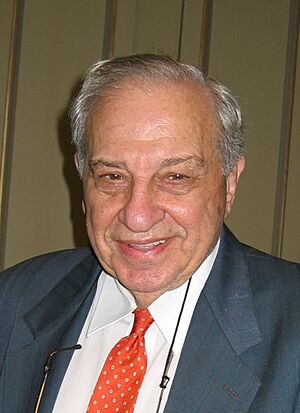Rudolph A. Marcus facts for kids
Quick facts for kids
Rudolph A. Marcus
|
|
|---|---|

Marcus in 2005
|
|
| Born |
Rudolph Arthur Marcus
July 21, 1923 |
| Nationality | |
| Education | McGill University (BSc, PhD) |
| Known for | Marcus theory RRKM theory |
| Spouse(s) |
Laura Hearne
(m. 1949; died 2003) |
| Children | 3 |
| Awards |
|
| Scientific career | |
| Fields | Chemistry |
| Institutions |
|
| Thesis | Studies on the conversion of PHX to AcAn (1946) |
| Doctoral advisor | Carl A. Winkler |
| Doctoral students | Gregory A. Voth |
| Other notable students | Postdocs:
|
Rudolph Arthur Marcus (born July 21, 1923) is a famous Canadian-American chemist. He won the Nobel Prize in Chemistry in 1992. He received this award for his important work on how electron transfer happens in chemical reactions.
His most famous idea is called Marcus theory. This theory helps scientists understand how electrons move from one atom or molecule to another. This movement is super important for many things, including how our bodies work and how plants make food. Marcus is a professor at Caltech and also at Nanyang Technological University in Singapore.
Contents
Early Life and Education
Rudolph Marcus was born in Montreal, Quebec, Canada. His family came from Lithuania. He spent most of his childhood in a Jewish neighborhood in Montreal. He also lived for a short time in Detroit, United States.
From a young age, Rudolph was very interested in science. He was especially good at math in high school. He went on to study at McGill University. There, he took many math classes, which later helped him create his famous theory about electron transfer. He earned his first degree in 1943 and his PhD in 1946, both from McGill University. In 1958, he became a citizen of the United States.
Career and Discoveries
After finishing his studies in 1946, Marcus worked at different research places. He then became a professor at the Polytechnic Institute of Brooklyn.
In 1952, he helped create something called RRKM theory. This theory helps explain how molecules break apart during chemical reactions. Later, in 1964, he taught at the University of Illinois. Marcus is known for tackling problems head-on, always giving his full effort. In 1978, he moved to the California Institute of Technology, which is often called Caltech.
Understanding Electron Transfer
Electron transfer is one of the most basic types of chemical reactions. It's when an electron moves from one chemical substance to another. Even though it sounds simple, life as we know it couldn't exist without it!
For example, electron transfer happens in our bodies when we breathe. It also happens in plants during photosynthesis, which is how they turn sunlight into energy. When we eat food, our bodies use electron transfer to get energy. Here's a simple example:
- Two hydrogen parts, two electrons, and half an oxygen molecule react.
- This reaction creates water and releases heat.
Because electron transfer is so common and important in nature, Marcus's theory became very valuable in chemistry and biochemistry.
One type of electron transfer that interested Marcus was how electrons move between metal ions (atoms with an electrical charge) that are in different states. For example, he studied how an electron moves between two different forms of iron ions in water. In the 1950s, scientists were puzzled by how slowly this reaction happened. This mystery made Marcus very curious about electron transfer.
Through his studies, Marcus developed his detailed theory. His ideas led to many new experiments. These experiments helped scientists in all areas of chemistry and biochemistry understand more about how reactions work.
Rudolph Marcus is still actively doing research, even after his 100th birthday!
Awards and Recognition
Rudolph Marcus has received many honors and awards for his amazing work. He has been given honorary degrees from many universities around the world. These include the University of Chicago, McGill University, and the University of Oxford.
Before winning the Nobel Prize in Chemistry in 1992, he received many other important awards. Some of these include:
- The Irving Langmuir Award in Chemical Physics (1978)
- The Wolf Prize in Chemistry (1984-1985)
- The National Medal of Science (1989)
- The Linus Pauling Award (1991)
He was also chosen to be a member of important scientific groups. These include the National Academy of Sciences and the American Academy of Arts and Sciences. In 1987, he became a Foreign Member of the Royal Society, which is a very high honor in science.
In 2019, he received the Fray International Sustainability award.
See also
 In Spanish: Rudolph Marcus para niños
In Spanish: Rudolph Marcus para niños
- Henry Taube, another Nobel Prize winner who studied electron transfer.
- List of Jewish Nobel laureates

